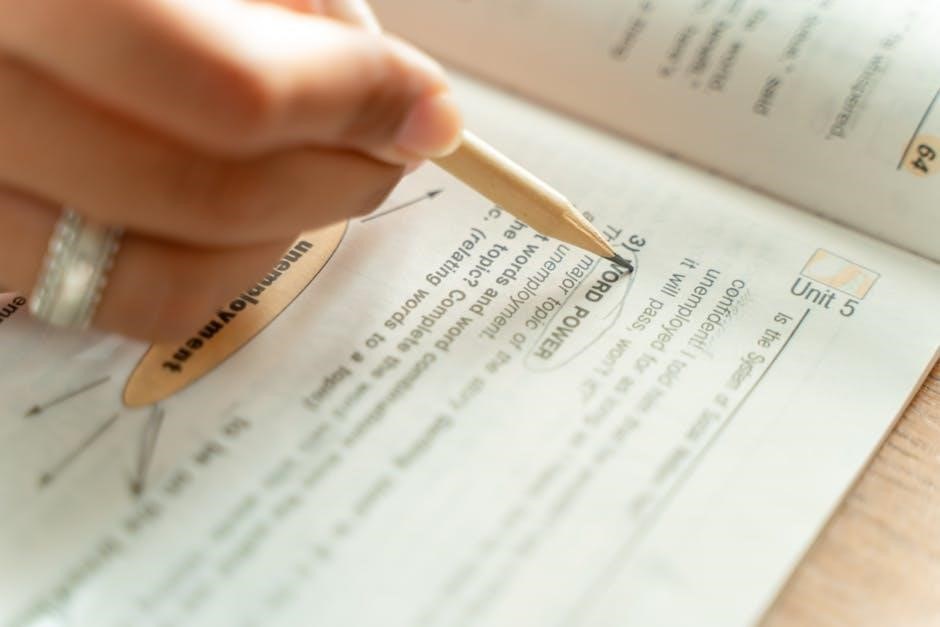The nail technician exam is a critical step to becoming a licensed professional, ensuring competence in safety, techniques, and sanitation. A study guide is essential for thorough preparation.
Understanding the Exam Format
The nail technician exam typically consists of two main sections: a written test and a practical demonstration. The written portion includes multiple-choice questions covering theory, while the practical part assesses hands-on skills.
2.1 Written Examination
The written examination evaluates theoretical knowledge, focusing on sanitation, safety, and nail-related topics. It includes multiple-choice questions testing understanding of procedures, chemical safety, and legal standards. Topics like nail diseases, tools, and products are emphasized. Study guides and practice exams, such as those from PSI Test Prep and Mometrix, provide similar question formats; Time management is crucial, as exams are timed; Reviewing state-specific regulations and industry standards is also essential; A comprehensive study plan ensures thorough preparation for this section. Utilizing online resources and video tutorials can enhance understanding of complex concepts. Practice exams help identify weak areas, allowing focused study. Proper time management during the exam is key to success.
2.2 Practical Examination
The practical examination assesses hands-on skills in nail care procedures, such as manicures, pedicures, and nail enhancements. Candidates must demonstrate precision, safety, and adherence to sanitation protocols. Tasks are timed, and students are evaluated on their ability to complete services efficiently while maintaining quality. Practice exams and study guides, like those from PSI Test Prep and Mometrix, offer insights into expected techniques. Focusing on common procedures and safety standards is crucial for success. Regular practice and review of practical skills ensure confidence and readiness for the exam. Utilizing video tutorials can also help refine techniques and improve performance under timed conditions.

Key Topics Covered in the Exam
The exam covers sanitation, safety, nail diseases, and common techniques like manicures and enhancements. Study guides, such as Mometrix, provide detailed insights into these essential topics.
3.1 Sanitation and Safety Procedures
Sanitation and safety are paramount in the nail technician exam, ensuring a clean environment for clients. Key topics include proper disinfection of tools, sterilization methods, and use of personal protective equipment (PPE). The exam also covers understanding chemical allergies, such as hydroxyethyl methacrylate (HEMA), and safe handling practices. Students must demonstrate knowledge of bloodborne pathogen protocols and proper waste disposal. Study guides, like Mometrix, emphasize these critical procedures to prevent infections and maintain client trust. Regular review of safety standards is essential for exam success and professional competence.
3.2 Nail Diseases and Disorders
Understanding nail diseases and disorders is crucial for nail technicians to provide safe and effective services. Common conditions include fungal infections (onychomycosis), nail psoriasis, and brittle nail syndrome. Technicians must identify symptoms like discoloration, thickening, or separation from the nail bed. They should also recognize allergic reactions, such as those caused by chemicals like HEMA. Proper protocols ensure client safety and prevent further complications. Study guides highlight these conditions, emphasizing the importance of accurate diagnosis and appropriate responses. This knowledge is essential for both practical exams and real-world applications, ensuring technicians can address client concerns responsibly and ethically.
3.3 Common Nail Techniques
Mastering common nail techniques is essential for success in the nail technician exam. Key skills include proper manicuring and pedicuring, nail tip application, and gel or acrylic extensions. Sanitation protocols must be strictly followed during these procedures to ensure client safety. Techniques such as shaping, buffing, and polishing are fundamental and frequently tested. Study guides often highlight these methods, providing step-by-step instructions and tips for perfection. Practicing these techniques builds confidence and proficiency, which are critical for both the written and practical exam portions. Understanding the tools and materials used in these processes is also vital for delivering professional results.

Effective Study Strategies
Effective study strategies involve creating a structured plan, utilizing online resources, and practicing time management. Prioritize understanding key concepts and regularly test knowledge through practice exams.
4.1 Creating a Comprehensive Study Plan
A well-structured study plan is essential for success in the nail technician exam. Begin by identifying key topics and allocating time for each section, ensuring coverage of sanitation, techniques, and safety. Break down study material into manageable chunks, focusing on understanding rather than memorization. Incorporate practical exercises, such as mock exams, to assess progress. Regularly review and revise concepts, staying updated on industry standards. Utilize resources like Mometrix’s study guide and video tutorials to reinforce learning. Consistency is key; dedicate specific hours daily to maintain momentum. Tailor the plan to address weak areas and ensure ample time for revision before the exam.
4.2 Utilizing Online Study Resources
Leveraging online study resources is crucial for effective exam preparation. Platforms like PSI Test Prep and Mometrix offer comprehensive study guides, practice questions, and video tutorials tailored for nail technician exams. These resources provide in-depth insights into key topics such as sanitation, nail diseases, and techniques. Utilize online forums and communities to discuss challenging concepts and gain tips from experienced professionals. Additionally, practice exams available online help familiarize yourself with the exam format and timing. Dedicate time daily to explore these resources, focusing on weak areas to improve comprehension and confidence. Structured use of online tools ensures a well-rounded preparation strategy.
4.3 Time Management Techniques
Effective time management is vital for successful exam preparation. Allocate specific time slots for studying, practicing, and revising. Prioritize challenging topics and dedicate more time to mastering them. Use a planner or calendar to organize study sessions, ensuring consistent progress. Incorporate short breaks to maintain focus and avoid burnout. Practice exams can help assess readiness and identify areas needing improvement. Set realistic goals for each study session to stay on track. By balancing study time with relaxation, you can maintain productivity and mental well-being. A structured schedule ensures efficient use of time, leading to better retention and confidence for the exam.

Importance of Practice Exams
Practice exams are essential for familiarizing yourself with the exam format, identifying weaknesses, and building confidence. They simulate real test conditions, helping you refine your skills and strategies effectively;
5.1 Tips for Taking Practice Exams
Taking practice exams effectively requires simulating real test conditions. Set a timer, find a quiet space, and avoid distractions. Use a study guide to access realistic questions and familiarize yourself with the exam format. Review your answers to identify mistakes and understand correct reasoning. Consistently practicing helps build confidence and improves time management. Focus on weak areas identified through practice results to strengthen your knowledge. Mix up question types to ensure well-rounded preparation. Track your progress to gauge improvement and adjust your study plan accordingly. Regular practice exams are key to achieving success in the actual nail technician exam.
5.2 Analyzing Exam Results
Analyzing exam results is crucial for identifying strengths and areas needing improvement. Review each question, focusing on incorrect answers to understand mistakes. Use a study guide to clarify concepts and retention strategies. Track progress over time to monitor improvement. Identify patterns in errors to refine study focus. Prioritize weak areas in your study plan and seek additional resources, such as video tutorials, for complex topics. Regular analysis helps build confidence and ensures comprehensive preparation for the nail technician exam. By addressing gaps systematically, you can achieve a higher score and master the required skills effectively.
Licensing Requirements
Licensing is required after passing the exam, with requirements varying by state; Some jurisdictions have specific rules, and state boards issue licenses upon completion of educational hours and exams.
6.1 State-Specific Licensing
State-specific licensing requirements vary significantly across jurisdictions. Each state sets its own criteria for obtaining a nail technician license, including educational hours, exam formats, and renewal processes. For example, Illinois requires completion of a state-approved program and passing a computer-administered exam. North Carolina mandates testing for out-of-state applicants or those reinstating lapsed licenses. California enforces strict sanitation protocols, while other states may require additional certifications. It’s essential to check local regulations to ensure compliance. Licensing ensures adherence to safety and professional standards, protecting both technicians and clients. Understanding state-specific rules is crucial for a seamless licensing process and professional practice.
6.2 License Renewal Process
The license renewal process for nail technicians varies by state but generally requires periodic renewal, often biennially. Most states mandate continuing education hours to stay updated on industry standards and safety protocols. Technicians must submit a renewal application, pay fees, and provide proof of completed courses. Some states may require additional certifications or background checks. It’s crucial to adhere to renewal deadlines to maintain active licensure and avoid penalties. Each state’s specific requirements ensure ongoing competency and compliance with professional standards, safeguarding both practitioners and clients.
Top Recommended Study Resources
Popular study resources include PSI Test Prep and Mometrix’s Nail Technician Study Guide, offering practice questions, video tutorials, and detailed lessons to ensure exam success effectively.
7.1 Best Study Guides
The Mometrix Nail Technician Study Guide and the Technician Exam Secrets Study Guide are highly recommended for comprehensive preparation. These guides provide detailed lessons, practice questions, and video tutorials to cover all exam topics. They focus on key areas such as sanitation, nail diseases, and techniques, ensuring a thorough understanding. Both guides are designed by exam experts and are updated regularly to reflect current standards. They also include tips for time management and strategies to reduce exam anxiety. These resources are ideal for both beginners and experienced technicians aiming to excel in the nail technician exam.
7.2 Helpful Video Tutorials
Video tutorials are an excellent supplement to written study materials, offering visual demonstrations of key techniques. Platforms like YouTube and specialized beauty education websites provide step-by-step guides on sanitation procedures, nail art, and product application. Mometrix, for example, offers video lessons alongside their study guides, covering topics like safety protocols and common nail diseases. These tutorials are particularly useful for understanding practical skills, such as proper tool usage and infection control. They also allow learners to pause, rewind, and review complex procedures, enhancing retention. Video tutorials are a valuable resource for both theoretical knowledge and hands-on practice, making them indispensable for exam preparation.

Exam Day Preparation
Ensure you arrive early, bring required documents, and avoid last-minute cramming. Stay calm, review final tips, and follow all exam protocols to perform your best.
8.1 Final Preparation Tips
On exam day, arrive early to avoid stress and ensure all materials are organized. Review your checklist to confirm you have everything needed. Avoid last-minute cramming and focus on relaxation techniques to maintain a clear mind. Stay hydrated, eat a light meal, and dress comfortably. Visualize success to boost confidence. Double-check the exam location and timing to prevent delays. Ensure your tools and equipment are clean and properly stored if required. Stay positive, take deep breaths, and trust your preparation. Remember, consistency and practice have equipped you with the knowledge to excel. Approach the exam with calmness and professionalism.
8.2 What to Bring to the Exam
Ensure you bring all necessary materials to the exam, such as your valid ID, admission ticket, and any required tools specified by the testing center. Pack a nail kit with basic tools like clippers, files, and cuticle pushers if applicable. Bring pens, pencils, and a notepad for written sections. Stay organized with a clear bag for easy inspection. Include snacks, water, and any personal items for comfort during breaks. Double-check the list of prohibited items to avoid issues. Arrive prepared with all documents and supplies to ensure a smooth experience. Being well-equipped will help you focus on demonstrating your skills and knowledge confidently.